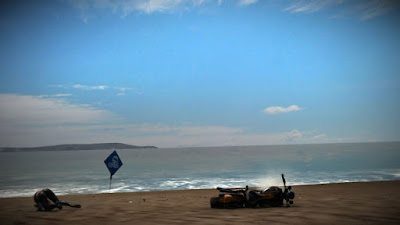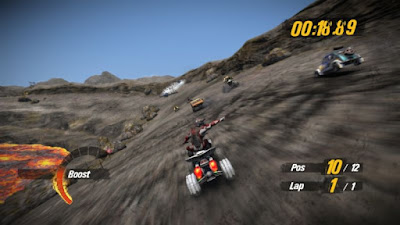 |
| Source // PlayStation |
Nearly 100 games have gone by since I last saw MotorStorm. I ended that write up by saying "I'm not sure how people who didn't play it at launch will see it, though. Hopefully, with a smile at least."
I also mentioned in that write up that I hadn't played any of its sequels, and now that the time has come to play MotorStorm: Pacific Rift, where we're going to put that statement to the test. Will I see this sequel with a smile at least? Has MotorStorm's time in the sun long gone? Does anything hold up 13 years later?
Enough waffle, crank up the volume and let's get this festival rocking.
 |
| Source // PlayStation |
Fun Times
Crank down the volume, the soundtrack isn't as memorable as the first game, but crank up the colours of your swanky new HDTV to make the vibrant paradise of Pacific Rift really pop. The first game showed it could do sand, rocks, sandy rocks, and mud in a variety of ways, sure, but the locales were repetitive after a short while.
Here in the pacific, the oranges are replaced by greens, and those greens replaced by greys, browns, and back to orange again as the landscape takes us through, well, paradise - as envisioned by mental racers with a blatant disregard for their wellbeing.
 |
| Source // MobyGames |
 |
| Source // PlayStation |
 |
| Source // MobyGames |
 |
| Source // MobyGames |
If MotorStorm was considered bland, Pacific Rift simply cannot be, not in the sense of its looks at least. Once again, the game will take you through a bunch of races locked between festival tickets, with each successful podium placement giving you some points towards the next unlock - the better you do, the faster you progress, of course.
 |
| Source // MobyGames |
As before, races usually involve different vehicle classes for you to drive, from fragile motorbikes and ATVs to mudsluggers and buggies, all the way up to trucks and - new to the series - monster trucks. Each has its advantages and disadvantages, and you can work out what they may be.
 |
| Source // MobyGames |
 |
| Source // MobyGames |
 |
| Source // MobyGames |
All vehicles come equipped with a boost, and it has been given more of a gameplay function in this sequel.
In MotorStorm, I would often use the boost to help me turn a corner, something that continues to be a necessary tactic in Pacific Rift, but we'll get to the handling in a moment. In Pacific Rift, this boost bar - which once again can be used whenever and wherever you like - is affected by nearby sources of water, where it cools down and allows you to boost even more, or lava, where it catches fire and increases your chance of exploding, which obviously isn't good.
"Lava?" I hear your question. Yes, lava. Racing on cliff edges isn't extreme enough for the competitors in Pacific Rift. Not content with racing their motorbike wheel to wheel with a monster truck, these guys and gals want to skirt the edge of active volcanoes, too.
 |
| Source // MobyGames |
 |
| Source // MobyGames |
 |
| Source // MobyGames |
This added danger gives you another thing to worry about when racing. Not only can you be crushed in an instant by a competitor, or swatted into the nearest tree or rock, but you can drown in a river or catch fire jumping over lava in a desperate bid to nab first place before the end of the race.
 |
| Source // MobyGames |
 |
| Source // MobyGames |
 |
| Source // MobyGames |
Frustrations
If you drive a car into a body of water (or lava), its destruction is on you. Likewise, if you make a bad turn and clip a rock, you've only got yourself to blame.
However... When playing Pacific Rift you tend to notice all the times when it's not your fault, and there are a lot of times where it feels like you could do nothing to avoid an accident. You can make a turn only to find yourself under the wheels of a truck. You can skirt the edge of a path only to find a tree that is definitely sturdier than the vegetation around it. You can take a path clearly designed for your type of vehicle, and then emerge into the path of another vehicle, dropping on you from a height.
This is MotorStorm in a nutshell - chaos. Death is brushed aside with a near-instant resetting of your vehicle, but by that time, you've lost 5 places and the leader is now long gone. You might as well restart your race if you're hunting for perfection, and on some tickets, you need near-perfection, as a wreck limit is in place and you simply won't progress if you smash yourself into oblivion one too many times.
 |
| Source // PlayStation |
 |
| Source // PlayStation |
A game can still be enjoyable if you're wiping out every other minute, especially if you're swiftly returned to the action, but if you're only given the choice of racing on an ATV, but half of the field are stomping around the circuit in trucks, you may well start to curse what MotorStorm wants you to do.
The idea of each circuit is that there are paths for light vehicles to take, up high and along the edges where they can stay out of trouble, and paths for lumbering vehicles to just smash their way through, usually right down the middle and covered in mud.
This design is nice, and you need to learn these multiple paths through a track to have any chance of winning, but there are inevitably crossover points where vehicles can and will go bumper to bumper, and any collision can spell disaster, even if you don't outright crash.
 |
| Source // PlayStation |
I honestly don't know which of these two vehicles the player is driving here. I want to say the jeep, rather than the ATV, but that's not really the point here. The point is that at low speeds, vehicles tend to tangle up, and the physics goes a bit weird.
I had instances, especially in buggies, where a single little clip would cause me to be run over for an instant death, but the same clip at a slightly different angle would result in throwing my buggy onto two wheels or spinning it around, or otherwise just slowing it down to an uncomfortable degree, as both you and the AI driver fight to regain control without too much lost time - a fight that will inevitably not go in either driver's favour.
If you're gunning for a podium, any slight clip and scuffle could spell disaster. I don't know what, if any, rubber banding system is in play, but as Pacific Rift went on, I was getting more and more irate with every little thing that happened against me.
Even when you're free to drive without the threat of being driven in, you've got to struggle with the controls of your car as it slides across the mud, flies through the air, or splashes through a river. Lord help you if you're trying to get to grips with an ATV.
Nothing ever felt comfortable, not completely. You could get the hang of something, but never quite be sure of what it'll do at any given point. You can learn the circuit enough to know which route is designed for your car, but would never quite feel like you'd made the best choice.
 |
| Source // MobyGames |
Why worry when you're seconds away from wiping out anyway?
Final Word
When I played MotorStorm way back in 2006 or so, I battled through the bullshit to complete it. I must have liked it, must have wanted to do well, must have had nothing else to work towards. I wanted to do something similar with Pacific Rift. Frankly, I wanted to like it. But I couldn't. Or at least it was making life difficult to do so.
Pacific Rift is exactly the kind of thing MotorStorm needed after its impressive first showing: more variety and some tweaking to the system. It was still hectic, still showing off some impressive stages, still frustratingly difficult in places and great fun in others. It was MotorStorm and then some. More of the same, but better.
Fast forward 13 years and it's a slightly different story. The controls, and the physics especially, are distinctly MotorStorm-y, in a bad way. Well, not bad bad, but bad in a way that isn't found today for a reason. In fact, the studio would go on to make a modern MotorStorm-like title in the form of Onrush, which had some wacky ideas for the genre, but just didn't gain any traction with players.
It's sad because in both MotorStorm and Onrush was something special. It just wasn't special to enough people. MotorStorm had a great look and feel but on paper rather than in-game. To get the most out of the games, you couldn't be a casual player. You had to put the effort in.
For a game that sold itself as an over-the-top vehicular-themed music festival, the idea of the spectacle was more appealing than the game based in that spectacle.
Make no mistake, if you like MotorStorm and can put up with its quirky controls and out-of-nowhere insta-kills, you'll find in Pacific Rift a game that will give you the same thrills. If you're not a fan of the first game, Pacific Rift's new environments may give you a reason to give it a second chance, but you're likely not a fan of the first game because of the handling, rather than the graphics, and Pacific Rift doesn't make it any easier.
It's nice to have finally played it, though. I don't think I've got any of the other sequels to play, so I guess if I do want to go back there's something new to experience. Well, new to see. I know what the experience is like - and know enough to want it in small doses these days.
Fun Facts
Destroyed cars can litter the track, their owners (somehow still alive) seen standing beside the track watching on - and apparently close enough to be driven over. That sounds interesting enough to fire it up again and look out for it, but then I remember just how much effort it takes to stay alive in this game and think better of it...
MotorStorm: Pacific Rift, developed by Evolution Studios, first released in 2008.
Version played: PlayStation 3, 2008.